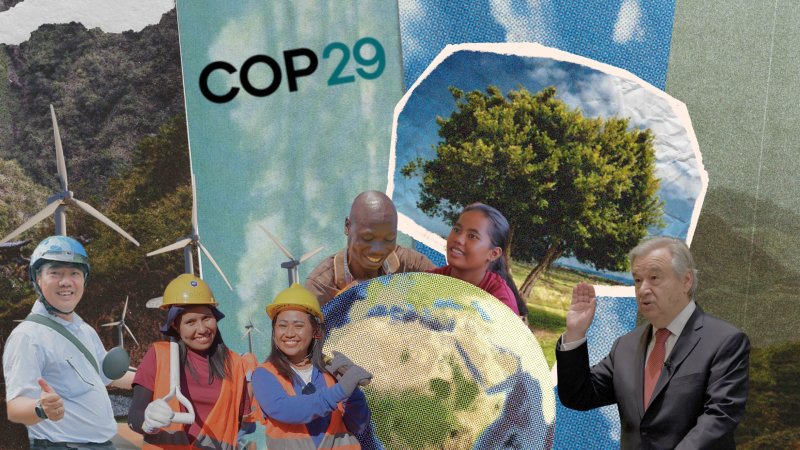The COP conference, short for Conference of the Parties, is the world’s most important annual gathering on climate change, News.Az reports.
It brings together almost every country on Earth to discuss and negotiate actions to combat global warming and its impacts. The term “Parties” refers to the nations that have signed the United Nations Framework Convention on Climate Change (UNFCCC), an international treaty established in 1992 to stabilize greenhouse gas emissions and prevent dangerous climate disruption.
COP conferences are held every year under the UNFCCC and serve as the main decision-making body for global climate policy. Each COP is hosted by a different country, with recent conferences including COP28 in Dubai (2023) and COP29 in Baku (2024). These meetings have grown into major global events, attracting not only government officials but also scientists, activists, business leaders, and journalists from around the world.
How the COP conference takes place
The COP conference usually lasts around two weeks and follows a structured process designed to encourage negotiation and consensus among nearly 200 participating countries.
Opening session:
The host country officially opens the conference, and delegates reaffirm the goals of the Paris Agreement and the UNFCCC. The agenda for discussions is adopted, setting the tone for negotiations.
Negotiations and working groups:
Delegates divide into smaller working groups to focus on specific topics — such as carbon markets, renewable energy financing, climate adaptation, deforestation, or support for developing nations. Technical experts and diplomats work together to draft proposals and policy texts.
High-level segment:
In the second week, heads of state, ministers, and senior officials join the conference. They deliver speeches outlining their countries’ climate policies and make new pledges or funding commitments. This stage often receives the most global attention.
Side events and pavilions:
Alongside official negotiations, the COP hosts hundreds of panels, exhibitions, and forums organized by governments, non-governmental organizations, and private companies. These events highlight new technologies, green innovations, and real-world climate solutions.
Final agreement:
After days of negotiation, delegates work toward a consensus document — such as the Paris Agreement (COP21, 2015) or the Global Stocktake (COP28, 2023) — summarizing the progress made and outlining next steps. Every country must agree to the final text before it can be adopted, which often leads to all-night discussions in the final hours of the conference.
Why the COP conference is needed
The COP is essential because climate change is a global problem that cannot be solved by any single country. Greenhouse gases emitted in one nation affect the entire planet, so coordinated international action is necessary. The COP provides a formal space where nations can negotiate, set goals, and hold each other accountable for progress.
The conference serves several critical purposes:
Setting global targets: COP meetings establish global goals for emission reduction, renewable energy development, and adaptation to climate impacts.
Reviewing progress: Every few years, countries must report on their progress in implementing their Nationally Determined Contributions (NDCs) — the emission targets agreed under the Paris Agreement. The Global Stocktake, held every five years, measures whether the world is on track to limit warming to 1.5°C.
Mobilizing finance: Developed countries use the COP to pledge financial support to developing nations that face greater risks from climate change. The Green Climate Fund, for example, aims to mobilize 100 billion dollars annually for climate projects.
Encouraging innovation: The COP brings together governments, scientists, and the private sector to promote new technologies such as hydrogen energy, carbon capture, and nature-based solutions.
Raising global awareness: Beyond political agreements, the COP draws worldwide attention to the urgency of the climate crisis, shaping public opinion and driving national policy changes.
Recent developments and outcomes
Over the past decade, COP conferences have produced some of the most significant climate agreements in history. The Paris Agreement, adopted at COP21 in 2015, remains the cornerstone of global climate action, uniting all countries around the goal of keeping global warming well below 2°C.
At COP28 in 2023, nations agreed for the first time to begin a “transition away from fossil fuels,” marking a turning point in climate diplomacy. The same conference also launched a Loss and Damage Fund to support countries affected by extreme weather events such as floods, droughts, and rising sea levels.
The upcoming COP29 in 2024 in Baku, Azerbaijan, is expected to focus on increasing climate finance for developing nations and strengthening global cooperation on renewable energy and hydrogen. Experts predict that this conference will play a decisive role in defining funding mechanisms for the post-2030 climate agenda.
Why COP matters for the future
The COP conference is more than just a diplomatic event — it is a global checkpoint for the planet’s future. It provides a rare forum where rich and poor nations, producers and consumers, and activists and corporations meet under one roof to discuss shared responsibility.
Although progress at these conferences can be slow and compromises are common, the COP remains the only international platform where legally binding climate decisions can be made. Without it, there would be no coordinated global framework to cut emissions, invest in clean energy, or protect vulnerable nations.
As the world faces record temperatures, severe droughts, and rising sea levels, the role of the COP conference is becoming more important than ever. It is where the global community turns commitments into action — and where humanity decides how to secure a livable planet for future generations.
